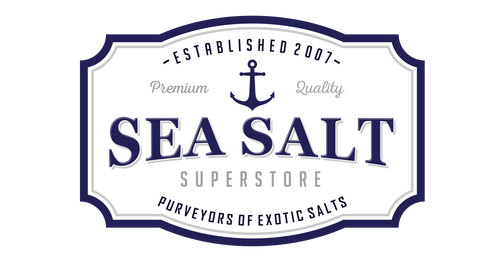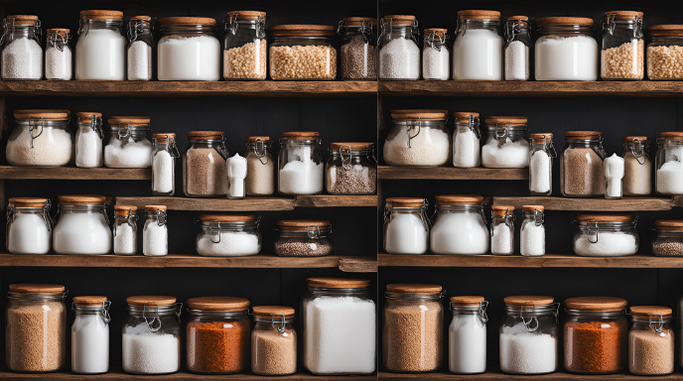Salt is an essential item in any prepper’s pantry, not just for seasoning but also for its long history as a preservative and its importance in food preservation, health, and survival. Because it is a non-perishable product, salt can last indefinitely if stored properly. Proper storage ensures that your salt remains free of contaminants and retains its effectiveness when you need it most. Here's how to store salt for the long-term, making sure it remains safe and useful for years to come.
1. Choose the Right Type of Salt
When preparing for long-term storage, it’s important to choose the type of salt that best suits your needs. While any salt will last indefinitely if stored correctly, some salts are better suited for different purposes.
-
Table Salt: Regular table salt is iodized and contains additives (like anti-caking agents) that might not be ideal for long-term storage, but it's widely available and inexpensive. If you opt for table salt, ensure that it’s stored in airtight containers to prevent moisture absorption.
-
Kosher Salt: Kosher salt is a good option for preppers because it’s pure and doesn’t contain iodine or additives. Its coarse grains also make it easier to measure when used for preservation or food preparation.
-
Sea Salt and Himalayan Pink Salt: These are great alternatives for those who prefer natural, unrefined salts. They may contain trace minerals, but like kosher salt, they can last for decades if stored properly.
-
Canning Salt: This is a specialized salt that contains no additives and is often used in food preservation, such as in pickling and canning. It's an excellent choice for long-term food storage.
2. Use Airtight Containers
The key to long-term salt storage is keeping moisture out. Salt is hygroscopic, meaning it absorbs moisture from the air. If exposed to humidity, it can clump, and in extreme conditions, it could even dissolve into a liquid. To prevent this, store your salt in airtight containers.
Ideal containers include:
- Mylar Bags with Oxygen Absorbers: For bulk salt storage, mylar bags sealed with an iron are an excellent option. Adding oxygen absorbers will remove the oxygen from the bag and further protect the salt from any moisture in the air.
- Food-Grade Buckets: Large, food-grade plastic buckets with airtight seals are perfect for storing salt in bulk. Be sure the lid is tightly sealed to prevent air or moisture from entering. For additional protection, consider vacuum-sealing smaller bags inside the bucket.
- Glass Jars: For smaller quantities, glass jars with tight-fitting lids (like Mason jars or repurposed glass containers) are ideal for storing salt. Glass is impermeable and doesn’t react with salt, keeping it safe and dry.
3. Store in a Cool, Dry Place
Temperature and humidity control are crucial for keeping your salt safe and dry. Ideally, salt should be stored in a cool, dry location away from direct sunlight and heat sources. Excess heat or humidity can cause salt to clump or degrade over time, even if it’s in an airtight container.
Recommended storage locations:
- Pantry or Closet: A dark, cool closet or pantry is perfect for salt storage. Avoid areas near the stove, oven, or other heat-producing appliances.
- Basement or Root Cellar: If you have a basement or root cellar, these can be excellent places to store salt long-term as they are often naturally cool and dry.
- Avoid Bathrooms and Kitchens: These areas tend to have higher humidity levels, which could compromise the salt. A dry environment is key.
4. Consider Vacuum Sealing for Smaller Quantities
Vacuum sealing is a great option for those who want to store smaller amounts of salt in airtight packaging. Not only does vacuum sealing protect the salt from moisture, but it also prevents contaminants and pests from getting inside.
- Use food-grade vacuum bags to seal salt in smaller portions, which are easier to manage and use as needed.
- Oxygen Absorbers: When vacuum sealing, add oxygen absorbers to remove any air inside the bag, ensuring a long shelf life.
5. Use Desiccants or Moisture Absorbers
Even when stored in airtight containers, it’s a good idea to include some form of moisture absorption to safeguard against humidity. Desiccants or moisture-absorbing packets (such as silica gel packets or calcium chloride) can be placed inside your salt containers to keep the environment dry.
- Silica Gel Packets: These can be added to containers to absorb any excess moisture in the air, preventing salt from clumping.
- Calcium Chloride: Often used in moisture-absorbing bags, this material can help keep salt free-flowing in bulk containers.
6. Avoid Salt Contamination
When storing salt for long-term use, avoid contaminating it with food oils, moisture, or any other materials that might spoil the salt. Always use clean, dry utensils when handling salt to prevent introducing moisture. For bulk storage, consider using food-grade gloves or scoops when handling large quantities.
7. Labeling and Rotation
If you're storing different types of salt or large amounts of bulk salt, labeling each container with the date of purchase or the packaging date is a helpful practice. Even though salt doesn't spoil, it’s still a good idea to keep track of your supplies to ensure you use the oldest batches first. This can be important if you're rotating salt stocks alongside other long-term food supplies.
Labeling tips:
- Include the type of salt and the date on the container.
- For mylar bags and buckets, you can write directly on the surface with a permanent marker or stick labels on the outside.
8. Storing Bulk Salt
For long-term preppers, bulk salt storage can be a priority. Buying salt in bulk (such as 25-pound or larger bags) ensures you have enough to last through emergencies, but bulk storage requires additional considerations.
- Mylar Bags and Buckets: As mentioned, Mylar bags and food-grade buckets are ideal for bulk salt. After sealing the salt in smaller bags within the bucket or Mylar, it’s ready for long-term storage.
- Dry Ice: In some cases, if you’re storing extremely large quantities of salt, you may want to use dry ice to help remove oxygen before sealing. However, this is usually reserved for more advanced long-term storage needs.
Conclusion
Salt is a vital resource for preppers, offering versatility as a seasoning, preservative, and essential item for survival. Properly storing salt ensures that it remains free from moisture and contaminants, preserving its effectiveness for long-term use. Whether you are storing it in Mylar bags, food-grade buckets, or glass jars, keeping salt in a cool, dry place and adding moisture absorbers will ensure it remains useful for years to come. By following these tips, you can secure an important element of your food storage plan and be prepared for any emergency.




